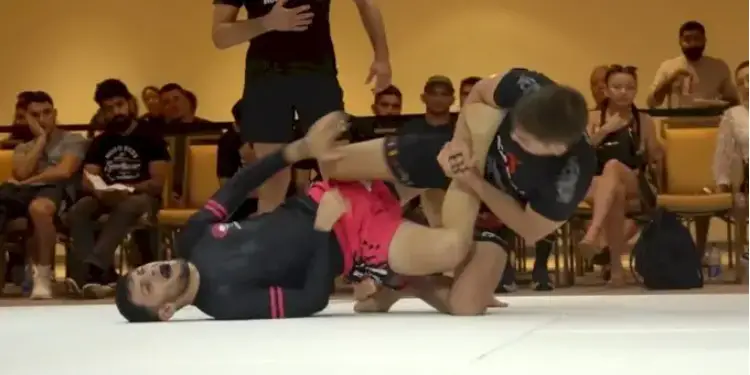Heel hooks are often referred to as one of the most dangerous techniques in all of submission grappling, but is that actually the truth? If you’d asked any BJJ black belts throughout the 1900s then you’d probably have gotten a resounding yes from almost every single one. In many gyms you might find the same sentiment about leglocks in general, you might have been told that they were ‘dirty’ or unsportsmanlike. For the longest time, a huge number of BJJ coaches looked down on leglockers and preached the danger of heel hooks to any of their students.
Are Heel Hooks Actually Dangerous?
Somehow, at the exact same time in many gyms around the world, plenty of grapplers were training leglocks on a daily basis and seemed to show no ill effects. While many BJJ gyms in the early 90s were still trying to bury their head in the sand, the earliest days of MMA in Japan were filled with pioneers of leg attacks. Masakatsu Funaki and Minoru Suzuki were using straight ankle-locks, kneebars, toeholds, and heel hooks to great effect all throughout the early years of Pancrase. These grapplers were by no means the first to use leglocks to submit their opponents and heel hooks have been around since the dawn of time, but this was the start of them being brought into modern grappling competition with the kind of frequency we see now.
If heel hooks were so dangerous, then surely there would be stories of training partners in Japan being taken to hospital on a regular basis. Even as leglock proficiency spread among other MMA fighters like Ken Shamrock and Bas Rutten, it wasn’t as if fans were seeing horrific injuries on a regular basis. Even in BJJ competition, ADCC promoted an open ruleset that included heel hooks from the very start in 1996 and it wasn’t as if that resulted in more injuries either. Then the leglock revolution happened in the years that followed and we still weren’t seeing knees exploding left and right, not in the competition mats or in the training room.
It turned out that heel hooks weren’t some highly dangerous technique and they are much like every other submission that was being practiced in every other gym. People are generally only getting hurt with leglocks if they’re very inexperienced, in freak accidents, or when they are too stubborn to tap. It’s always important to be careful with new people regardless of the technique being used, accidents can happen with any transition or submission, and while nobody should be punished for stubbornness in the training room; damage might be suffered if someone decides to test the limits of their resistance to any submission.
What Damage Can Heel Hooks Cause?
Although heel hooks may not be any more dangerous than other submissions, they’re not really any safer either. All joint-lock submissions are designed to cause damage to an opponent and the clear threat of that is what makes them tap. A heel hook should ideally be attacking the knee-joint, with the torque that the grappler generates being driven directly into the ligaments that stabilise the knee. The specific ligaments that are under attack depending on the configuration of the grappler’s legs, and which variation of the heel hook is being performed
The main variation comes in either inside or outside heel hooks, but there are an almost endless number of ways that leg configurations and body positioning can effect precisely where the pressure is being directed. Depending on these factors, the damage from a heel hook could be done to either the Anterior Cruciate Ligament (ACL) or the Posterior Cruciate Ligament (PCL), and potentially even the Medial Collateral Ligament (MCL) or the Lateral Collateral Ligament (LCL). The rest of the knee-joint isn’t entirely safe either, as heel hooks have been known to cause damage to the Meniscus and even the Patellar Tendon as well.
In rare cases, usually when damage to the knee-joint has already been incurred, heel hooks have been known to cause broken ankles as well. This tends to happen because the ligaments stabilising the knee are no longer functioning properly and they’re rotating out of the regular range to absorb the torque. Just because the knee-joint is now able to rotate more than it should, does not mean that the rest of the leg can do the same. All the power that was being transferred into rotating the knee then ends up going through the ankle instead, potentially causing it to break.
How Do You Practice Heel Hooks Safely?
The answer to this is relatively straightforward, because it’s the same as every other submission. Heel hooks aren’t inherently any more dangerous than any other submission, but they should still be treated with respect and training partners should be taken care of. Experienced grapplers shouldn’t be putting new partners in unfamiliar situations where they could potentially injure themselves, so nobody should be doing heel hooks on the trial class guy. Likewise, newer people shouldn’t be attempting to finish a submission that they have never actually been taught. Either one of these situations could very easily go wrong and a combination of the two of them (white belts heel hooking newer white belts) is an absolute recipe for disaster.
There are plenty of methods to get more acquainted with heel hooks too, as newer grapplers can drill safely, use positional sparring, or even employ a catch-and-release approach. Then as everyone in the room becomes more experienced with heel hooks, how dangerous they are drastically decreases and partners can start using them at full training-room speed. This is really how every submission should be learned, as it reduces the risk for injury and allows everyone to know not just how to tap, but when to tap as well.
So Why Do People Think Heel Hooks Are Dangerous?
This really dates back to the early days of Brazilian Jiu-Jitsu and unfortunately the truth has little to do with safety at all. All the way back in the 1940s, a man called Oswaldo Fadda was studying Jiu-Jitsu under Luiz Franca and teaching students completely separate from the Gracie family. Fadda opened up his own gym in 1950 on the outskirts of Rio de Janeiro, with a completely different ethos to the one that the Gracie family’s academies had. While the prices of instruction under a Gracie family member was generally too high for the local residents, Fadda believed in spreading it to those who could not have afforded it otherwise.
Fadda’s students specialised in the use of leglocks and some competition started to brew between the schools, leading up to a direct tournament in 1955. There’s conflicting reports of what the results of the matches were, with some sources claiming that Fadda’s school one and some claiming that the Gracie family’s students won. One thing that all sources seem to agree on is that at least some of Fadda’s students won matches and their use of leglocks caused a lot of trouble for the Gracie students. A second challenge took place in 1956 and the results of this one are clearer: Fadda’s school emerged victorious despite the crowd’s shouts of ‘Sapateiro!’ whenever they attempted leglocks.
In the decades that followed, the Gracie family’s legacy grew stronger and the level of influence they had over the sport of Jiu-Jitsu was gigantic. It’s not hard to connect the dots here to see why heel hooks and other leglocks were considered dangerous for so long. When you choose not to train them, the chance of injury undoubtedly increases as your situational and positional awareness is not as good as it could be. When the people with the biggest influence over Jiu-Jitsu don’t specialise in leglocks and consider them to be ‘dirty’ techniques, that approach bleeds out throughout the sport.
Thankfully, the efforts of the MMA world, ADCC, and other no gi grappling tournaments has started to erase that mindset from the modern Jiu-Jitsu world. There are still gyms everywhere who believe that heel hooks are particularly dangerous and should be banned, but they are now few and far between. When a particular heel hook finish in competition appears to cause damage, people still come out of the woodwork to criticise the technique or it’s application. In recent years though, they are drowned out by the voices of reason who recognise that these incidents are few and far between.
For more of our opinion pieces on various topics, visit our opinion piece archives.













